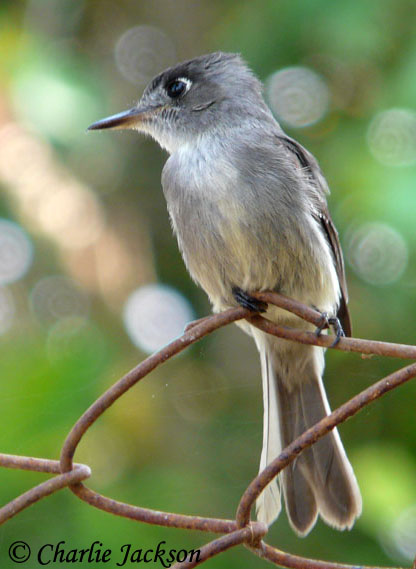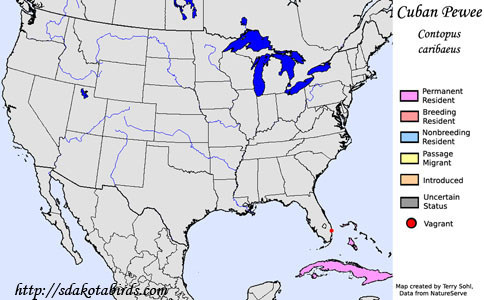| Length: 6.25 inches | Wingspan: 10.5 inches | Seasonality: Non-resident in South Dakota |
| ID Keys: White crescent behind eye, gray plumage overall, lighter underparts with faint yellowish tinge | ||
 The
Cuban Pewee is normally found in Cuba and islands in the western Caribbean.
They are but a rare vagrant to the United States, having first been
identified in the United States in 1995. They are very similar in
size, structure, and plumage to the Eastern Wood-Pewee, a quite common
species in the Eastern United States, and the two species share the same
general habitat preferences. Due to the similarity to the Eastern
Wood-Pewee, it is possible the species is a more frequent visitor to the
United States, but simply isn't identified very often. Due to the main
feature that differentiates it from other Pewee species, it is sometimes
referred to as the "Crescent-eyed Pewee". Formerly, the Cuban Pewee,
the Jamaican Pewee, and the Hispaniolan Pewee were all considered one
species, the Greater Antillean Pewee.
The
Cuban Pewee is normally found in Cuba and islands in the western Caribbean.
They are but a rare vagrant to the United States, having first been
identified in the United States in 1995. They are very similar in
size, structure, and plumage to the Eastern Wood-Pewee, a quite common
species in the Eastern United States, and the two species share the same
general habitat preferences. Due to the similarity to the Eastern
Wood-Pewee, it is possible the species is a more frequent visitor to the
United States, but simply isn't identified very often. Due to the main
feature that differentiates it from other Pewee species, it is sometimes
referred to as the "Crescent-eyed Pewee". Formerly, the Cuban Pewee,
the Jamaican Pewee, and the Hispaniolan Pewee were all considered one
species, the Greater Antillean Pewee.
Habitat: Found in a variety of forested habitats in their native range, from upland pine forests to coastal mangroves.
Diet: Feeds on insects and spiders, but will also sometimes consume small fruits and berries.
Behavior: Forages by observing from a perch, and either flying out to capture insects in flight, or flying and hovering briefly while gleaning insects from foliage.
Nesting: The nest of a Cuban Pewee is a small cup built of grasses, rootlets, lichens, moss, animal hair, or other fine materials. The female usually lays between 2 and 4 eggs, and the female alone incubates the eggs. Once the eggs hatch, both parents help to feed and raise the young. The young fledge after about 16 days.
Song: Song of a Cuban Pewee is a descending, squeaky whistling, WEEEooooo.
Migration: Considered a permanent resident throughout its normal range in the western Caribbean.
Interactive eBird Map: Click here to access an interactive eBird map of Cuban Pewee sightings
Similar Species: Very similar in overall appearance to the Eastern Wood-Pewee, a common species in the eastern United States. The white crescent behind the eye is the easiest way to differentiate the Cuban Pewee from the Eastern Wood-Pewee.
Conservation Status: Populations appear to be stable, and they are still relatively common in parts of their range. The IUCN lists the Cuban Pewee as a species of "Least Concern".
Further Information: 1) Audubon Guide - Cuban Pewee
2) Birdlife International - Cuban Pewee
3) Whatbird - Cuban Pewee
Photo Information: Photo taken by Charlie Jackson - March 30th, 2011 - Zapata, Cuba - Photo licensed under Creative Commons Attribution 2.0 Generic License.
| Click below for a higher-resolution map |
 |
| South Dakota Status: Non-resident in South Dakota |
Additional Cuban Pewee Photos (coming soon!!)
